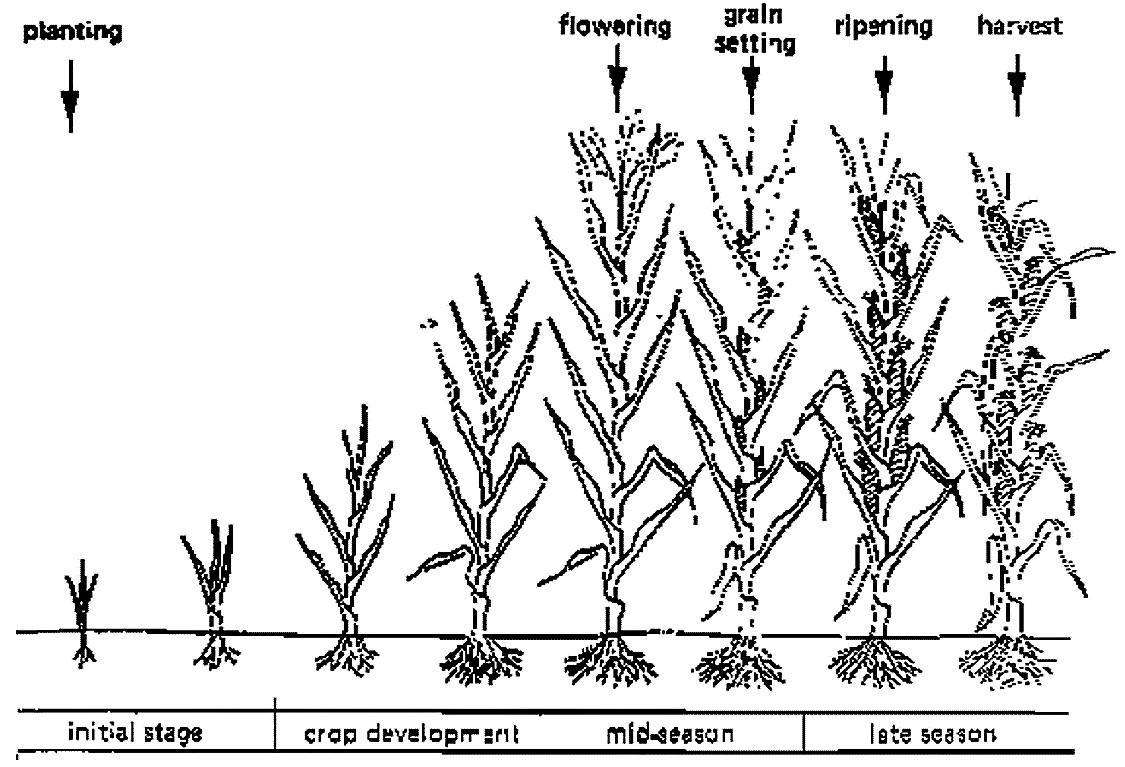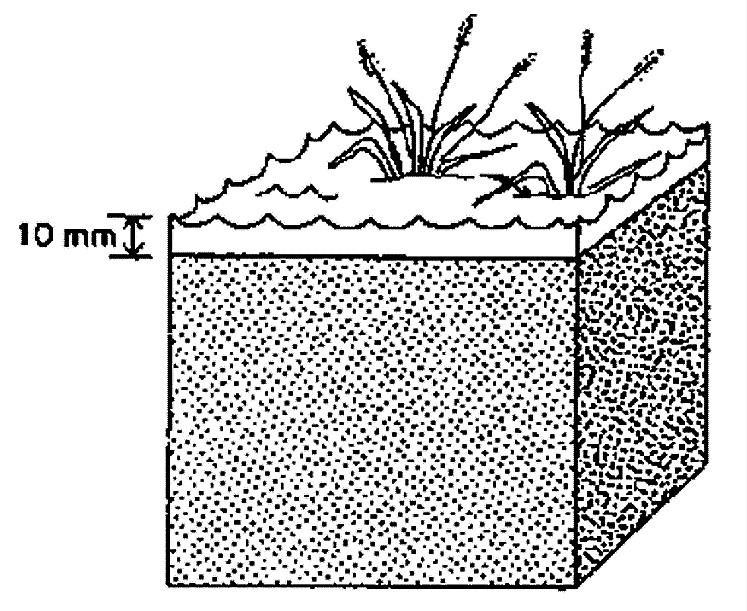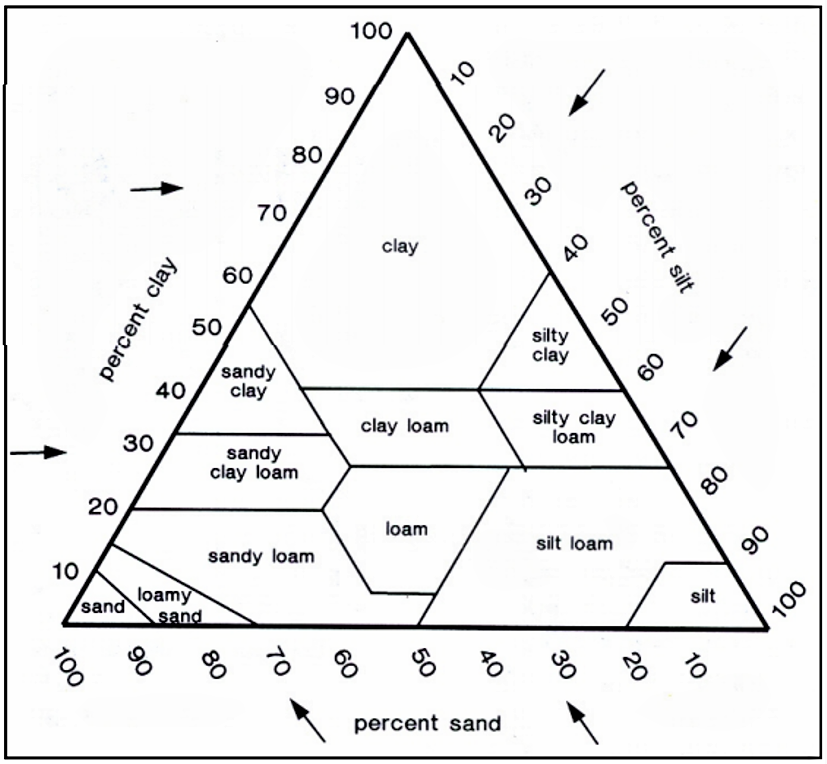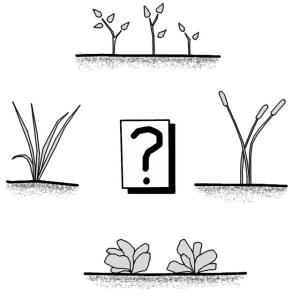Resumen ejecutivo
Different crops need different type of soils, different types and amounts of nutrients, and different types and amounts of water. The amount of water required by the plant is also dependent on the growing season and the climate where it is grown. By selecting the right crop for the given soil conditions and climate, one can optimise yields and save water requirements for irrigation.
| Entradas | Salidas |
|---|---|
Precipitation, Fertigation Water, Fertiliser, Compost/Biosolids, Treated Water |
Food Products |
Introduction
By selecting the right crop for given conditions, one can optimise the requirement of irrigation water and added fertiliser and increase yields.
The crop water needs mainly depend on:
- The climate
- The crop type
- The growth stage
The crop water needs are high in sunny, hot and windy climates and low in cloudy, cool, humid climates with little wind speed.
The Climate
In a sunny and hot climate, crops need more water per day than in a cloudy and cool climate. One has to consider the amount of rainfall and water loss trough percolation and evapotranspiration in order to calculate the right amount of irrigation water needed. Soil moisture conservation through mulching, tillage techniques, soil cover or soil amendment.
| Climatic zone | Mean daily temperature | ||
|
| Low (less than 15°C) | Medium (15 – 25°C) | High (more than 25°C) |
| Desert/arid | 4-6 mm | 7-8 mm | 9-10 mm |
| 4-5 mm | 6-7 mm | 8-9 mm | |
| Sub-humid | 3-4 mm | 5-6 mm | 7-8 mm |
| Humid | 1-2 mm | 3-4 mm | 5-6 mm |
Average daily water need of standard grass during irrigation season. Source: FAO (1986)
The Crop Type
There exist crops like rice or sugarcane, which need more water than crops like beans and wheat. The table below gives some idea about the different seasonal water needs of the most important field crops.
| Crop
| Crop water need (mm/total growing period) |
| Alfalfa | 800-1600 |
| Banana | 1200-2200 |
| Barley/Oats/Wheat | 450-650 |
| Bean | 300-500 |
| Cabbage | 350-500 |
| Citrus | 900-1200 |
| Cotton | 700-1300 |
| Maize | 500-800 |
| Melon | 400-600 |
| Onion | 350-550 |
| Peanut | 500-700 |
| Pea | 350-500 |
| Pepper | 600-900 |
| Potato | 500-700 |
| Rice (paddy) | 450-700 |
| Sorghum/Millet | 450-650 |
| Soybean | 450-700 |
| Sugar beet | 550-750 |
| Sugarcane | 1500-2500 |
| Sunflower | 600-1000 |
| Tomato | 400-800 |
Approximate values of seasonal crop water needs. Source: FAO (1986)
The Growing Stage

A fully-grown crop will need more water than a crop that has just been planted. It is estimated that 50% of the crop water is needed during the mid-season stage, when the crop is fully developed. During the so-called crop development stage the crop water need gradually increases to the maximum crop water need (100%). The maximum crop water need is reached at the end of the crop development stage, which is the beginning of the mid-season stage.
Fresh harvested crops, such as lettuce, cabbage, etc. need the same amount of water during the late season stage as during the mid-season stage. The crops are harvested fresh and thus they need water up to the last moment.
Dry harvested crops, such as cotton, maize (for grain production), sunflower, etc. are allowed to dry out and sometimes even die during the late season stage these crops. Thus their water needs during the late season stage are minimal.
Crop Selection
Water Needs
The water need of a crop is usually expressed in mm/day, mm/month or mm/season. Suppose the water need of a certain crop in a very hot, dry climate is 10 mm/day. This means that each day the crop needs a water layer of 10 mm over the whole area on which the crop is grown. It does not mean that this 10 mm has to indeed be supplied by rain or irrigation every day. For example, it is still possible to supply 50 mm of irrigation water every 5 days. The irrigation water will then be stored in the root zone and gradually be used by the plants: every day 10 mm will be used (adapted from FAO 1986). In terms of volume, with a rainfall of 10 mm, every square metre of the field receives 0.01 m, or 10 litres, of rain water. With a rainfall of 1 mm, every square metre receives 1 litre of rain water (FAO 1985).

Crop Rotation and Water Need
The success of conservation agriculture lies on a proper and good crop rotation plan. Different plant species or even varieties have different needs for nutrients, light, water, temperature and air. When one of these basic needs is not met, the plant will be stressed and will not grow properly. Selecting crop rotation varieties is therefore a very important exercise that a farmer needs to undertake (INFONET-BIOVISION 2010). The crop water need (ET crop) is defined as the depth (or amount) of water needed to meet the water loss through evapotranspiration. In other words, it is the amount of water needed by the various crops to grow optimally. The crop water need always refers to a crop grown under optimal conditions, i.e. a uniform crop, actively growing, completely shading the ground, free of diseases, and with favourable soil conditions (including fertility and water). The crop thus reaches its full production potential under the given environment. The crop water need mainly depends on (FAO 1986):
- The climate: in a sunny and hot climate crops need more water per day than in a cloudy and cool climate.
- The crop type: crops like maize or sugarcane need more water than crops like millet or sorghum.
- The growth stage of the crop; fully-grown crops need more water than crops that have just been planted.
Nutrient Requirements
Proper nutrition is essential for satisfactory crop growth and production. The use of soil tests can help to determine the status of plant-available nutrients to develop fertiliser recommendations in order to achieve optimum crop production.
There are at least 16 elements known, which are normally derived from the soil in the form of inorganic salts, to be essential for plant growth (see table below). 94 to 99.5 % of fresh plant material is made up of carbon, hydrogen and oxygen. The other nutrients make up the remaining 0.5 to 6.0 per cent.
Macronutrients refer to those elements that are used in relatively large amounts, whereas micronutrients refer to those elements that are required in relatively small amounts (adapted from MCKENZIE 1998).
| Supplied from air and water | Supplied from soil and fertiliser sources | |
|
| Macronutrients | Micronutrients |
| Carbon (C) | Nitrogen (N) | Zinc (Zn) |
| Hydrogen (H) | Phosphorous (P) | Copper (Cu) |
| Oxygen (O) | Potassium (K) | Iron (Fe) |
|
| Sulphur (S) | Maganese (M) |
|
| Calcium (Ca) | Boron (B) |
|
| Magnesium (Mg) | Chlorine (Cl) |
|
|
| Molybdenum (Mo) |
|
|
| Cobalt (Co) |
Essential Plant Nutrients. Source: MCKENZIE (1998)
All 13 elements must be present in the soil for plant use, in varying degrees of availability, to ensure both the immediate and long-term needs of the crop.
| Deficient | When an essential element is at a low concentration that severely limits yield and produces more or less distinct deficiency symptoms. Extreme deficiencies will lead to death of the plant. |
| Insufficient | When the level of an essential plant nutrient is below that required for optimum yields or when there is an imbalance with another nutrient. Symptoms of this condition are seldom evident. |
| Sufficient | When the concentration of an essential nutrient is present in adequate amounts for optimum crop growth. |
| Excessive | When the concentration of an essential plant nutrient is sufficiently high to result in a corresponding shortage of another nutrient. |
| Toxic | When the concentration of either essential or other elements is sufficiently high to reduce plant growth severely. Severe toxicity will result in death of plants. |
Some of the commonly used terms to describe levels of nutrient elements in plants include.Source: MCKENZIE (1998)
Plant tissue analysis measures nutrient levels in the plant during their growth. The supply of available nutrients is reflected in the nutrient content of the crop. Therefore, use of plant tissue analysis allows a producer to evaluate the effectiveness of fertiliser recommendations from a soil testing service. Producers who do not soil test can still use routine plant tissue analysis to evaluate their fertiliser management programme to determine whether they used the correct kinds and amounts of nutrient (adapted from MCKENZIE 1998).
Furthermore, while an efficient plant nutrition management is essential for producing sufficient and healthy food, it is also a very complex challenge. Read more about it in the “Guide to Efficient Plant Nutrition Management” (FAO 1998). An overview about different strategies in fertilisation in different regions of the world is given by FAO (2006).
Soil Texture

Soil texture is an important soil characteristic that drives crop production and field management. The textural class of a soil is determined by the percentage of sand, silt, and clay. Soils can be classified as one of four major textural classes: (1) sands; (2) silts; (3) loams; and (4) clays. Soils can be improved with help of tillage, soil cover and reforestation, soil amendment, mulching or adding compost. There are several soil properties which are influenced by the texture (BERRY et al. 2007):
- Drainage
- Water holding capacity
- Aeration
- Susceptibility to erosion
- Organic matter content
- Cation exchange capacity (CEC)
- pH buffering capacity
- Soil tilth
Sandy soils have large particles and gaps between them. This allows water and nutrients to drain away freely, making sandy soils less fertile than heavier soils. Sandy soils also tend to dry out in the summer. But they warm up quickly in spring (allowing seedlings a good start) and they are much easier to dig than clay-based soils. If your soil is sandy, you should have no trouble growing root vegetables (such as carrots and parsnips), but you may struggle with nutrient-hungry brassicas (such as cabbages and broccoli). Also, plants and trees with shallow roots are prone to drying out as sandy soils lose moisture faster than heavier soils (adapted from GROWVEG n.y.).
Clay and silt soils – ‘heavier soils’ – have small particles. This means water is less likely to drain away but the soil is more likely to become waterlogged. Heavier soils are fertile, but take longer to warm up in the spring and are harder to dig. If you have clay soil, you should find that brassicas (such as cabbages and broccoli) grow well, but root vegetables (such as carrots and parsnips) are likely to struggle as they have to push through the heavy, often compacted soil. Shallow-rooted trees (such as pear trees) are likely to thrive in this soil as it holds moisture better than sand (adapted from GROWVEG n.y.).
Crop selection for a more effective use of irrigation water is useful and adaptable for every farm. It needs at least some basic knowledge about soil texture, nutrient and water requirements. Furthermore, yield production due to better soil quality (e.g. infiltration rate, aeration, water holding capacity) can be improved if there are implemented some technologies such as mulching, tillage techniques, soil cover or soil amendment.
Soil Texture
Read more about the importance of soil moisture.
BERRY, W. KETTERINGS, Q. ANTES, S. PAGE, S. RUSSEL-ANELLI, J. RAO, R. DeGLORIA, S. (2007): Soil Texture. Ithaca: Cornell University Cooperative Extension URL [Visita: 09.04.2019]Irrigation Water Management: Training Manual No. 1 - Introduction to Irrigation
Introduction to Irrigation is the first in a series of training manuals on irrigation. As the title suggests, the manual contains an introductory discussion of irrigation topics that will be dealt with in greater detail in the subsequent elements of the series: it brings together explanatory notes on concepts, terms, methods and calculations that are basic to the discussion of the subject matter. In doing so this manual may serve as an easy reference in the study of irrigation.
FAO (1985): Irrigation Water Management: Training Manual No. 1 - Introduction to Irrigation. Rome: Food and Agriculture Organization of the United Nations (FAO) URL [Visita: 18.07.2012]Irrigation Water Management: Irrigation Water Needs
A handbook of the World Food and Agriculture Organisation for developing the right irrigation scheme. Part I of this manual allows the reader to make a rough estimation of the crop and irrigation water needs - without using any complicated calculations. Part II of this manual allows the reader actually to calculate - be it in a fairly simple manner - the crop and irrigation water needs. These calculations obviously lead to a greater accuracy, but they also require more time and background knowledge.
FAO (1986): Irrigation Water Management: Irrigation Water Needs. Rome : Food and Agriculture Organization of the United Nations (FAO) URL [Visita: 18.07.2012]Guide to Efficient Plant Nutrition Management
The Guide to efficient plant nutrition management addresses some major issues related to the agronomic management of plant nutrients in an attempt to ensure both enhanced and sustainable agricultural production and to safeguard the environment.
FAO (1998): Guide to Efficient Plant Nutrition Management. Rome: Food and Agriculture Organization of the United Nations (FAO) URL [Visita: 09.04.2019]Fertilizer Use by Crop
This publication is based on 21 country reports on fertiliser use by crop issued by FAO between 2002 and 2006. Its objective is to demonstrate the importance of information on fertiliser use by crop, not only on a national level but also by agro-ecological zone, or in even greater detail. It also aims to demonstrate how the correct use of fertilisers could help to achieve the first target of the Millennium Development Goals (MDGs) of the United Nations, i.e. eradicate extreme poverty and hunger.
FAO (2006): Fertilizer Use by Crop. Rome : Food and Agriculture Organization of the United Nations (FAO) URL [Visita: 29.02.2012]Crop Nutrition and Fertilizer Requirements
Efficient application of the correct types and amounts of fertilisers for the supply of the nutrients is an important part of achieving profitable yields. This article mentiones the moist important points.
MCKENZIE, R. (1998): Crop Nutrition and Fertilizer Requirements. Lethbridge: Alberta Agriculture, Food and Rural Development URL [Visita: 18.07.2012]Crop Water Use and Growth Stages
A short overview about irrigation needs of crops, their water demand and different growth stages. This three page overview is very comprehensibly written and easy to read. It is an introduction to crop selection.
AL-KAISI BRONER (2009): Crop Water Use and Growth Stages. Colorado State University Extensions: Fort Collins URL [Visita: 09.04.2019]Soil Texture
Read more about the importance of soil moisture.
BERRY, W. KETTERINGS, Q. ANTES, S. PAGE, S. RUSSEL-ANELLI, J. RAO, R. DeGLORIA, S. (2007): Soil Texture. Ithaca: Cornell University Cooperative Extension URL [Visita: 09.04.2019]Irrigation Water Management: Training Manual No. 1 - Introduction to Irrigation
Introduction to Irrigation is the first in a series of training manuals on irrigation. As the title suggests, the manual contains an introductory discussion of irrigation topics that will be dealt with in greater detail in the subsequent elements of the series: it brings together explanatory notes on concepts, terms, methods and calculations that are basic to the discussion of the subject matter. In doing so this manual may serve as an easy reference in the study of irrigation.
FAO (1985): Irrigation Water Management: Training Manual No. 1 - Introduction to Irrigation. Rome: Food and Agriculture Organization of the United Nations (FAO) URL [Visita: 18.07.2012]Irrigation Water Management: Irrigation Water Needs
A handbook of the World Food and Agriculture Organisation for developing the right irrigation scheme. Part I of this manual allows the reader to make a rough estimation of the crop and irrigation water needs - without using any complicated calculations. Part II of this manual allows the reader actually to calculate - be it in a fairly simple manner - the crop and irrigation water needs. These calculations obviously lead to a greater accuracy, but they also require more time and background knowledge.
FAO (1986): Irrigation Water Management: Irrigation Water Needs. Rome : Food and Agriculture Organization of the United Nations (FAO) URL [Visita: 18.07.2012]Guide to Efficient Plant Nutrition Management
The Guide to efficient plant nutrition management addresses some major issues related to the agronomic management of plant nutrients in an attempt to ensure both enhanced and sustainable agricultural production and to safeguard the environment.
FAO (1998): Guide to Efficient Plant Nutrition Management. Rome: Food and Agriculture Organization of the United Nations (FAO) URL [Visita: 09.04.2019]Soil Physical Constraints to Plant Growth and Crop Production
This publication considers root requirements of the soil environment, the role of soil structure including its maintenance and improvement, tillage and the effects of water storage and irrigation on crop production. The significance of soil biota and organic matter in maintaining and improving soil structure is also emphasised. The case for use of conservation tillage systems to reduce crusting and erosion is addressed, and details of simple water harvesting and irrigation methods, which make effective use of the soil physical environment, are also presented.
GARDNER, C.M.K. LARYEA, K.B. UNGER, P.W. (1999): Soil Physical Constraints to Plant Growth and Crop Production. Rome: Food and Agriculture Organization of the United Nations (FAO) URL [Visita: 18.07.2012]Field Estimation of Soil Water Content. A Practical Guide to Methods, Instrumentation and Sensor Technology
The purpose of this manual is to provide guidance for field scientists who are not instrumentation experts but who wish to determine soil water content as part of their work. This publication is targeted to help those setting up soil water monitoring projects in the developing countries where expertise in many technologies is not readily available. However, it also has value to anyone planning a project involving the determination of field soil water content. Most importantly, it will also give some guidance as to what corroborative measurements are needed to check the performance of water sensing technology being used.
IAEA (2008): Field Estimation of Soil Water Content. A Practical Guide to Methods, Instrumentation and Sensor Technology. Vienna: International Atomic Energy Agency (IAEA) URL [Visita: 18.07.2012]Intercropping and Push-Pull
This chapter of Infonet Biovision provides additional information about intercropping and crop rotation. The reader gets to know about difficulties, means and practices.
INFONET BIOVISION (2012): Intercropping and Push-Pull. Zurich: URL [Visita: 09.04.2019]Crop Selection - Adapting to Climate Change in Africa
This paper examines whether the choice of crops is affected by climate in Africa. Using a multinomial logit model, the paper regresses crop choice on climate, soils, and other factors. The model is estimated using a sample of more than 7,000 farmers across 11 countries in Africa.
KURUKULASURIYA, P. MENDELSOHN, R. (2007): Crop Selection - Adapting to Climate Change in Africa. Washington, D.C.: The World Bank URL [Visita: 18.07.2012]Crop Nutrition and Fertilizer Requirements
Efficient application of the correct types and amounts of fertilisers for the supply of the nutrients is an important part of achieving profitable yields. This article mentiones the moist important points.
MCKENZIE, R. (1998): Crop Nutrition and Fertilizer Requirements. Lethbridge: Alberta Agriculture, Food and Rural Development URL [Visita: 18.07.2012]Fertilizer Use by Crop
This publication is based on 21 country reports on fertiliser use by crop issued by FAO between 2002 and 2006. Its objective is to demonstrate the importance of information on fertiliser use by crop, not only on a national level but also by agro-ecological zone, or in even greater detail. It also aims to demonstrate how the correct use of fertilisers could help to achieve the first target of the Millennium Development Goals (MDGs) of the United Nations, i.e. eradicate extreme poverty and hunger.
FAO (2006): Fertilizer Use by Crop. Rome : Food and Agriculture Organization of the United Nations (FAO) URL [Visita: 29.02.2012]Corn and Water
Corn is the most widely cultivated grain in the world, ahead of both wheat and rice. Read more about the advantages of this crop.
LIMAGRAIN (2010): Corn and Water. Chappes: Limagrain URL [Visita: 23.04.2012]Crop Rotation
This online article describes the crop rotation system, what it is, its effects and practices.
Water Requirement of Different Crops
A website about various crops and their requirement for water.
Crops
The Ontario Ministries website offers a lot of information about different needs of crops. This includes soil types, crop types, nutrient management, water management and general agriculture tips.

